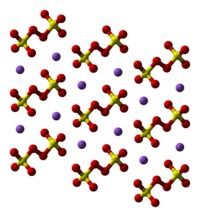
Photo from wikipedia
Persulfate-based in situ chemical oxidation (ISCO) has been increasingly used for the remediation of contaminated groundwater and soil. In recent years, there have been numerous studies in the literature on… Click to show full abstract
Persulfate-based in situ chemical oxidation (ISCO) has been increasingly used for the remediation of contaminated groundwater and soil. In recent years, there have been numerous studies in the literature on all aspects of the activation of persulfate for contaminant removal at the laboratory scale, including the ways and mechanisms for the activation, the pathways of contaminant degradation, the factors associated with the activation performance, the methods characterizing the processes, etc. In contrast, studies in the literature on the practical use of the activated persulfate at the field scale are fewer, and at the same time have not been reviewed in an organized way. This review was initiated to summarize on the current research on the applications of activated persulfate for actual site remediation, and to extract the knowledge necessary for the formation of applicable technologies. The remediation efficiency and mechanism of activated persulfates by heat, alkaline, metal-based, and electrokinetic activated technologies are described. The major factors including pH, the persistence of persulfate, and the radius of influence and soil property during ISCO remediation applications were presented and discussed. Finally, the rebound process and impact towards microbial communities after in-situ chemical oxidation on site application were discussed.
Journal Title: Applied Sciences
Year Published: 2023
Link to full text (if available)
Share on Social Media: Sign Up to like & get
recommendations!